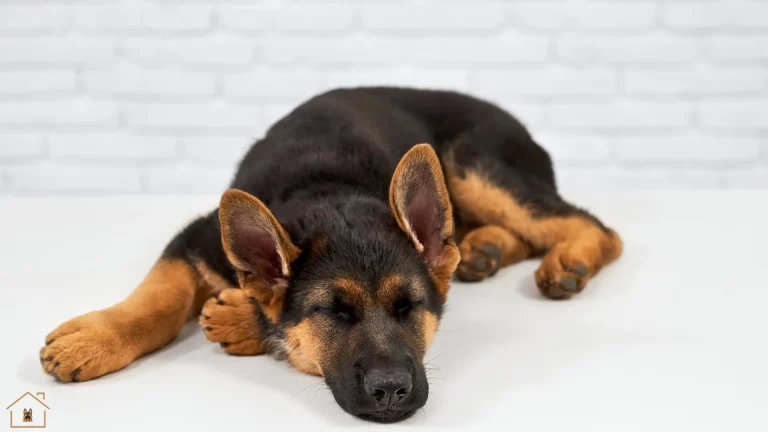Safe Essential Oils Around Dogs: What’s Okay and What’s Not
One evening, we were invited for a doggy play date by a friend. As we entered the house, the air was thick with the smell of lavender oil, and my German Shepherd instantly started twitching his nose at the scent. We took the dogs out to the yard and the play date went smoothly, but the experience stayed with me, and led me to wonder, are the safe essential oils for dogs really safe, or could they be toxic for our pups?
It turns out that essential oil safety for dogs is more complicated than I thought. Some oils truly help, while others are dangerous. In this guide I’ll share lessons and expert advice on dog-safe aromatherapy, covering safety rules, best-and-worst oils, and how to use them responsibly. We’ll look at which safe essential oils for dogs are okay and how to dilute and diffuse them, which are toxic, plus how to spot poisoning and when to call the vet.
Why Essential Oil Safety Matters for Dogs
Dogs experience scents on a totally different level than we do. Explaining dogs smell sensitivity, veterinarian Dr. Sarah Nold says, “Pets have a much more sensitive sense of smell than we do. What seems mild to us can be overwhelming, or even harmful, to a dog.”
For example, an oil’s aroma can irritate a pup’s respiratory tract, cause coughing or sneezing, or trigger an allergic reaction. And because dogs metabolize chemicals differently, their liver and skin can’t process oil compounds the same way ours do.
“Essential oil molecules can be rapidly absorbed and metabolized by the liver, so undiluted oils can be especially problematic for puppies, small breeds, senior dogs, or any dog with liver issues,” she adds.
The thing to keep in mind about essential oil safety for dogs is that just because something is natural or safe for humans, it does not mean it’s automatically safe for pets. Veterinary experts warn that while some oils can be beneficial, others can be toxic, and in some cases, essential oil toxicity in pets can even prove to be life-threatening.
Proper dilution, good ventilation, and keeping oils out of your dog’s reach are non-negotiable. Simple practices like always opening a window when diffusing and using only pet-safe concentrations can go a long way in protecting your pet while you indulge in some aromatherapy.
How Essential Oils Affect Dogs
Essential oils can enter a dog’s body in three main ways:
- Through the lungs by inhalation
- Across the skin by dermal absorption
- If licked or ingested
Once in the system, the potent plant compounds can cause a range of effects. Inhaled oils may irritate a dog’s airways. Smaller breeds or brachycephalic dogs are especially prone to trouble. Absorbed oils can enter the bloodstream quickly, potentially stressing organs. Dogs with immature or compromised liver function are at higher risk because they lack certain enzymes to detoxify these substances.
Early warning signs of overexposure include,
- Drooling
- Excessive pawing at the face/mouth
- Skin redness
- Vomiting
Veterinary surgeon Dr. Edele Grey explains, “Often the first clues are like mild irritation such as salivation, pawing, or nausea. After that, you may see difficulty breathing, tremors, ataxia, seizures and coma in extreme cases.”
Watch for wobbliness or coughing as well. Note that puppies and little dogs often show symptoms faster and more severely. If you notice any signs of distress after diffusing an essential oil, it calls for immediate action. Here are some steps you need to take:
- Remove the source
- Get fresh air
- Call the vet or Pet Poison Helpline
Essential Oils That Are Safe for Dogs

Even though caution is key, there are a few essential oils generally regarded as safe for dogs when used properly. Here are some that I’ve used:
Lavender Oil
Lavender is arguably the top choice for dog-safe aromatherapy. It’s known for calming properties and may ease anxiety or help with sleep. I often diffuse a drop of lavender to help settle my German Shepherd whenever he’s feeling anxious. Dr. Nold agrees that lavender is among the most calming essential oils pets, saying, “While there isn’t much clinical evidence that aromatherapy is beneficial to animals, the strongest support is for the use of lavender, chamomile, and sandalwood scents to reduce anxiety and have a positive effect on behavior and mood.”
That said, it must still be used sparingly. Here are some precautions to bear in mind:
- Dilute before use: Always mix with a carrier oil or water. A typical ratio is 1 drop of lavender oil per 50–100 ml of carrier/water, depending on the dog’s size
- Ventilate: Never keep a diffuser on too long, and make sure your pet has the option of leaving the room if needed
- Skin contact: If applying topically, like in a spray or shampoo, do a patch test on a small area first. Do not apply straight oil on fur or skin
- Watch out: Even with lavender, watch your dog’s reaction. If there’s redness, scratching, or aversion to the scent, stop use and rinse any treated area
Chamomile Oil
Chamomile is another gentle oil I’ve used for my dogs. It’s soothing for skin irritations, like hot spots or inflammation, and can also calm nerves. While chamomile is much gentler for dogs than most other essential oils, you should still make sure it’s not ingested and your dog doesn’t have unsupervised access to it. Precautions to follow:
- Never ingest: Do not let your dog lick or ingest it. Always use it externally or in a diffuser
- Allergy check: Even though it’s among the most soothing oils pets, some dogs might be sensitive to plants in the daisy family. Yep, chamomile’s a daisy! Do a small patch test first
- Ventilation: As with lavender, diffuse in a well-ventilated space and allow an escape route
Frankincense Oil
Frankincense is prized for immune support and gentle grounding effects. It’s said to have mild anti-inflammatory properties, and some holistic vets even use it for joint discomfort in dogs. For home use, I keep it simple: a drop or two in a diffuser, mixed with lavender, can aid relaxation. Precautions to keep in mind:
- Inhalation only: I stick to diffusing frankincense rather than topical use. Dogs usually sniff a bit and move on
- High-quality oil: Only use a therapeutic-grade frankincense. Adulterated oils can carry unexpected chemicals
- Avoid ears: Never put frankincense, or any oil, for that matter, in your dog’s eyes, nose, or ears
- Watch mood and skin: Some dogs may feel sleepy or mellow, which is fine. If your dog sneezes or rubs its nose, reduce concentration
Ginger and Cardamom Oils
These spicy oils are less common, but I’ve found them useful in easing an upset stomach or car-sickness in dogs. Ginger oil is renowned for relieving nausea. Cardamom oil also supports digestion and adds warmth to a blend. Precautions for use:
- Use vet guidance: I treat these like herbs or supplements. Before offering anything internally, check with a vet
- Skin check: Even if applying in diluted form, do a patch test. Both oils are relatively safe but it’s best to err on the side of caution
- Short diffusion: For motion sickness, a very light diffusion is usually enough. Never diffuse them constantly
- Quality matters: Ensure oils are pure and organic. Some ginger oils have additives that could upset dogs
Essential Oils That Are Toxic to Dogs
Some oils should be completely off-limits around dogs. Here are the one that are particularly hazardous:
Tea Tree Oil
Tea tree oil is infamous for its toxicity to dogs. Even a tiny amount of pure tea tree oil can poison a dog. There have been reports where as little as seven drops of 100% tea tree oil has caused poisoning in dogs, and exposure in larger amounts can be lethal. Symptoms of tea tree poisoning include,
- Drooling
- Weakness
- Skin irritation
- Incoordination
- Tremors
- Collapse
- Seizures
- Coma
Because tea tree oil is used in many products, such as shampoos and cleaners, in diluted forms, it’s important to check labels before buying or using such products. Never use tea tree oil on or near your dog. Don’t diffuse it around them.
Eucalyptus and Peppermint Oils
Eucalyptus and peppermint can freshen a home for us, but they can be upsetting for pups. Both oils have menthol-like compounds. If inhaled or ingested by a dog, eucalyptus oil can cause,
- Excessive drooling
- Vomiting, diarrhea
- Difficulty breathing
Peppermint oil, being high in menthol, may lead to gastrointestinal upset, vomiting or diarrhea as well. Any signs of distress after exposure to either of these oils should prompt an emergency vet visit.
Citrus and Pine Oils
Citrus oils such as orange, lemon, lime, grapefruit, as well as pine oils appear in many cleaners and diffusers, but they’re risky for dogs. Citrus oils contain psoralens that can irritate skin and upset the stomach. They may also stress the liver. Pine oils contain phenols that are especially dangerous and can cause liver failure and nerve damage.
Cinnamon and Wintergreen Oils
Cinnamon and wintergreen are potent compounds that dogs process poorly. Dr. Nold warns, “Even in small amounts, cinnamon oil can be toxic to dogs.” It can irritate skin and cause GI upset, and in large doses affect the liver and nervous system. Wintergreen, often labeled as sweet birch, contains very high methyl salicylate. If a dog licks or ingests it, it can cause intense drooling, vomiting, rapid breathing, seizures, kidney failure and even coma. These oils should never be used around pets.
Safe Ways to Use Essential Oils Around Dogs

If you do want to use essential oils at home, follow these safety practices:
Proper Dilution and Application
Always dilute oils in a large carrier, like coconut, olive or sweet almond oil, before any skin contact. Dr. Murl Bailey advises, “Essential oils should never be given by mouth or in the animal’s food because ingestion can cause vomiting, diarrhea and even seizures.”
Every dog parent should take this advice seriously. To avoid any harm to my dog, I make it a point to mix just 1 drop of oil per 50–100 ml of carrier oil. Even then, I always do a spot test on my own skin first. When applying these to my pet, I limit myself to my dog’s neck or shoulders, so he can’t lick it off. If I put essential oil on myself, I make sure he doesn’t lick it off my skin.
Diffusing Oils Safely
When using a diffuser, keep sessions short and in a well-ventilated area. Typically, diffusing oils briefly in a secured area that your dog cannot access is not likely to be an issue. Even so, I always allow my dog to leave the room if he wants. Of course, keeping the diffuser out of my pet’s reach is a no-brainer. I also watch out for signs of discomfort like coughing, pacing, or sneezing, especially when using a new oil, and turn it off at the first sign of trouble.
Using Oils for Cleaning or Odor Control
Essential oils are in many natural cleaning recipes, but caution is vital. If I mix oils into a cleaner, I only do it when the dogs are out of the room. For example, I might add a few drops of lemon oil to white vinegar for a floor cleaner, then wipe and rinse the floor well, and then ensure the surface dries before allowing my pet to have access to the area. In general, I prefer using pet-safe commercial cleaners or simple soap-and-water for areas my dogs frequent.
Signs of Essential Oil Poisoning in Dogs

Early recognition can save your dog’s life. Watch for these red flags, especially after any oil exposure:
- Drooling and pawing at the mouth: Excess saliva, drooling or pawing at lips/mouth often come first
- Gastrointestinal upset: Vomiting or diarrhea (sometimes with blood) can occur if ingested
- Skin irritation: Red, irritated skin at the contact spot or burns on the tongue are warning signs
- Neurological effects: Lack of coordination, tremors or seizures are serious neurological symptoms and can be signs of severe poisoning
- Respiratory distress: Coughing, wheezing or labored breathing signals airway irritation
- Lethargy or collapse: A pet that suddenly seems weak, unresponsive or limp is an emergency
What to do if you spot these:
- Stop exposure immediately. Turn off diffusers and move your dog into fresh air
- Remove any oil from skin by gently wiping with a soft towel or bathing with mild dish soap
- Never induce vomiting unless your vet explicitly says so. Inhaling oily vomit can worsen lung injury
- Call your veterinarian or pet poison control center right away for guidance. Be ready to tell them which oil or product was involved
If advised, you may be instructed to bring your dog in for activated charcoal treatment or supportive care. Quick action is crucial. The sooner you seek help, the better the outcome.
Vet Recommendations for Pet Aromatherapy
Veterinarians stress the importance of professional guidance. Before trying any essential oil treatment, talk with your vet or a certified veterinary aromatherapist. Only use therapeutic-grade, pure oils from reputable brands, not “fake” blends. Some holistic vets and certified aromatherapists can recommend safe dilutions and blends tailored to dogs.
Also, pay attention to labels: many products say “for dogs” or “kidney-safe” but read the ingredients to be sure. Only use oils specifically identified as dog-friendly. Store oils out of reach, and keep veterinary contact info handy. Remember, a dog-safe oil is only so when used correctly. If your vet recommends a specific oil or blend, follow their ratio exactly. If anything goes wrong, emergency veterinary care is the only fix.
FAQs About Essential Oils and Dogs
- Can I diffuse essential oils with my dog nearby?
Yes, but with caution. Keep diffusing sessions short and in a room your dog can exit. The ASPCA notes that a brief diffuser session in a secure area is usually fine, but dogs with breathing problems should avoid it. Always ensure ventilation and watch your pet’s reaction. If your dog seems distressed and shows signs like panting, sneezing, pacing, turn it off. And never let a diffuser run continuously all day. - What essential oils calm dogs naturally?
Lavender and chamomile top the list. Many dog owners report these scents soothe anxiety. Vets support this. Dr. Nold says that the strongest support is for the use of lavender, chamomile, and sandalwood scents to reduce anxiety. Frankincense is also often cited for relaxation. Always dilute these oils heavily and introduce them slowly. Remember every dog is different. What calms one may irritate another. - What oils should I avoid in homemade cleaners?
Steer clear of citrus and pine oil-based cleaners, as these can irritate dog’s skin and organs. Also avoid tea tree and peppermint in cleaning solutions. If you must use a scented cleaner, do it when your dog isn’t home and rinse surfaces well. Better yet, use certified pet-safe cleaning products or simple unscented cleaners with natural extracts. Always rinse and air out floors or counters before letting your dog back. - Can essential oils help with fleas?
No, essential oils are not approved flea treatments. In fact, veterinarians explicitly advise against using essential oils for fleas. Dogs can be more harmed by the oils than the fleas are by them. Instead, stick to vet-recommended flea and tick preventives that are proven to be safe and effective.
Takeaway
In the end, the key is balance: you can enjoy the benefits of dog-safe essential oils by using them carefully, but remember that some oils are outright toxic. Stick with the safe essential oils for dogs listed above and always assume any new oil could be dangerous until you verify otherwise. Consult your vet or a holistic pet specialist before trying anything new. Keep an essential oil safety pets checklist handy: dilution, ventilation, and rapid response to any symptoms. By following proven guidelines and seeking professional advice, you can create a healthy, aromatherapy-friendly home where you can enjoy pleasant scents and keep your dogs happy and safe at the same time.







